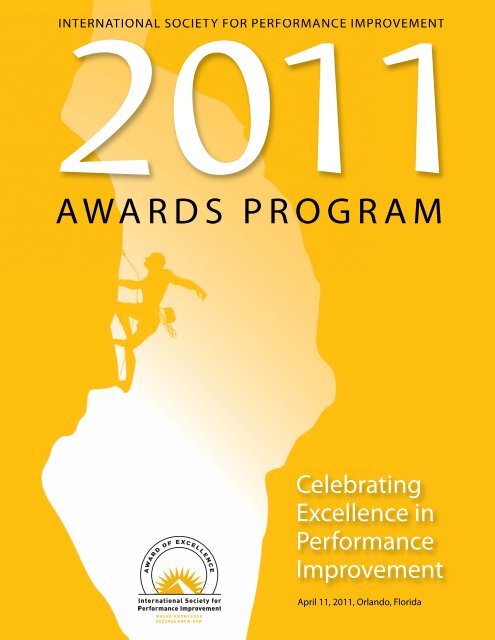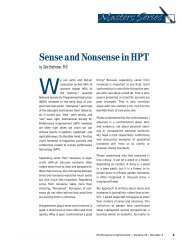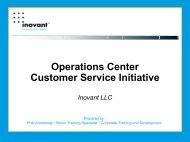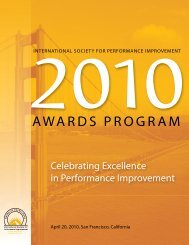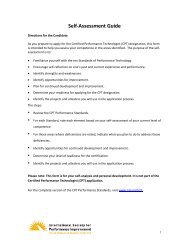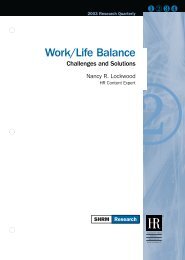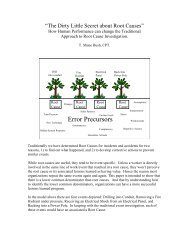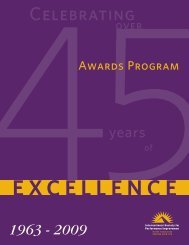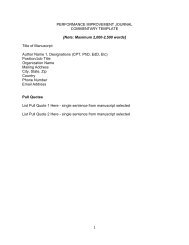awards program - International Society for Performance Improvement
awards program - International Society for Performance Improvement
awards program - International Society for Performance Improvement
You also want an ePaper? Increase the reach of your titles
YUMPU automatically turns print PDFs into web optimized ePapers that Google loves.
2011<br />
INTERNATIONAL SOCIETY FOR PERFORMANCE IMPROVEMENT<br />
A WA R D S P R O G R A M<br />
Celebrating<br />
Excellence in<br />
Per<strong>for</strong>mance<br />
<strong>Improvement</strong><br />
April 11, 2011, Orlando, Florida
Honorary Life Member<br />
Mariano Bernardez, CPT, PhD<br />
ISPI’s Honorary Life Member Award honors one of our<br />
colleagues <strong>for</strong> the totality of his or her contributions to<br />
both ISPI and the field of HPT over the course of his or<br />
her career to date. This award is not necessarily awarded<br />
every year, as it requires the unanimous agreement of<br />
two consecutive ISPI Boards. ISPI is pleased to announce<br />
this year’s Honorary Life Member is Mariano Bernardez,<br />
CPT, PhD.<br />
Mariano joined ISPI in 1993 and has<br />
continually made significant contributions<br />
to the <strong>Society</strong>. He is a founding<br />
member of ISPI chapters in Argentina,<br />
Spain, and Mexico. He also helped found<br />
and then became the chapter president<br />
of one of the first ISPI virtual chapters,<br />
the Per<strong>for</strong>mance <strong>Improvement</strong> Global<br />
Network.<br />
In 1998, Mariano received a Chapter<br />
Leadership Award <strong>for</strong> Transitioning HPT<br />
into the 21st Century. In 2003, he earned<br />
his Certified Per<strong>for</strong>mance Technologist<br />
designation. In 2004, the membership<br />
elected Mariano to serve as a Director<br />
on the 2004-2005 ISPI Board of Directors.<br />
Since 1993, he has presented at every<br />
annual conference, as well as the ISPI<br />
Europe Conference.<br />
In Mariano’s professional career, he has<br />
published four human per<strong>for</strong>mance<br />
technology (HPT) books in Spanish, the<br />
first ones in that language. He has also<br />
published numerous HPT articles in<br />
English in a wide variety of professional<br />
journals and books, including<br />
Per<strong>for</strong>mance <strong>Improvement</strong> and<br />
Per<strong>for</strong>mance <strong>Improvement</strong> Quarterly.<br />
Mariano has been a consultant to the<br />
United Nations Development <strong>program</strong>, a<br />
partner <strong>for</strong> Andersen Consulting, and a<br />
managing partner <strong>for</strong> MBC Consulting,<br />
and is currently research professor, as<br />
well as the director of the Per<strong>for</strong>mance<br />
<strong>Improvement</strong> Institute at Sonora<br />
(Mexico) Institute of Technology.<br />
Mariano’s range of professional expertise<br />
and interests include:<br />
• E-Per<strong>for</strong>mance (1998-2002): Model<br />
to design and integrate virtual per<strong>for</strong>mance<br />
systems and organizations,<br />
which was implemented on three<br />
continents<br />
• Knowledge factory (1999-2003):<br />
Virtual per<strong>for</strong>mance system to<br />
produce and deliver intellectual<br />
capital, which was implemented on<br />
three continents<br />
• Mega-planning application (1996-<br />
2002): Nine-year success and application<br />
case <strong>for</strong> Salta, Argentina, region,<br />
Refinor refineries, and the creation of<br />
120 new companies<br />
• Per<strong>for</strong>mance-centered university<br />
(2005): New model <strong>for</strong> graduating<br />
organizations and contributing to<br />
social improvement; 1,200 jobs<br />
created in 24 companies throughout<br />
Mexico<br />
• Double-bottom-line business case<br />
(2007): Methodology and tools to<br />
measure Mega, Macro, and Micro<br />
results and return on investment<br />
Given his contributions to the field and<br />
ISPI, Mariano truly is the tangible expression<br />
of ISPI’s Honorary Life Member.<br />
2
Thomas F. Gilbert Distinguished<br />
Professional Achievement Award<br />
Allison Rossett, CPT, EdD & Ken Silber, CPT, PhD<br />
Named after a foundational contributor<br />
to the field of human per<strong>for</strong>mance<br />
technology, this award recognizes those<br />
who have made outstanding contributions<br />
to the knowledge and practice of HPT.<br />
This year the award is bestowed on two<br />
longtime members Allison Rossett, CPT,<br />
EdD and Ken Silber, CPT, PhD.<br />
The pinnacle of good engineering<br />
is the elegant solution. Scientists,<br />
engineers, and mathematicians<br />
devote their careers to explaining<br />
and expressing vastly complex<br />
concepts in the simplest possible<br />
terms. In other words, they strive<br />
to be pithy.<br />
Allison’s contributions to HPT take<br />
the familiar <strong>for</strong>ms of publications,<br />
presentations, and positions of<br />
influence—too many to mention<br />
here. Yet most would agree what<br />
sets Allison apart from her peers<br />
is her ability to communicate<br />
and capture the attention of her<br />
audience. She is one of our profession’s<br />
most inspirational champions.<br />
Her presentations are relevant,<br />
her examples vivid, and her books<br />
are practical.<br />
In this age of in<strong>for</strong>mation overload,<br />
the ability to communicate and<br />
capture attention is the next big<br />
thing. Allison has long recognized<br />
complexity does not necessarily<br />
impress and simplicity does not<br />
necessarily compromise. In short,<br />
she understands the importance of<br />
engineering elegance and the value<br />
of being pithy. Allison’s ability to<br />
communicate has inspired thousands<br />
of people around the globe<br />
to be passionate about discovering<br />
root causes and designing the<br />
correct solutions to systemically<br />
improve per<strong>for</strong>mance. Her presentations<br />
are typically standing room<br />
only and her messages transfer to<br />
the workplace.<br />
Allison’s First Things Fast and A<br />
Handbook of Job Aids have greatly<br />
influenced the U.S. Coast Guard.<br />
Dave Hartt, CDR, USCG (Ret.),<br />
who studied under her, reports<br />
her work directly and dramatically<br />
influenced the Coast Guard’s<br />
approach to front-end analysis<br />
and the integration of job aids to<br />
ensure good stewardship of tax<br />
dollars while carrying out Coast<br />
Guard missions around the globe.<br />
Allison’s <strong>for</strong>mer students are<br />
helping to create the future of<br />
ISPI, and they count her as both<br />
a mentor and friend. Colleen<br />
Cunningham, Department of<br />
Defense, shares that Allison has<br />
“the uncanny ability to foster a<br />
greater understanding of the<br />
intersection of training and HPT.”<br />
And Chris Voelkl, head of advisory<br />
services at E&E In<strong>for</strong>mation<br />
Consultants in Germany, shares<br />
that Allison “opened doors <strong>for</strong><br />
many of us and by doing so has<br />
generated a vivid stream of fresh<br />
talent, ideas, and volunteer support<br />
without which the field of HPT<br />
could not endure.”<br />
•••<br />
Ken is an associate professor emeritus<br />
of Northern Illinois University,<br />
a part-time faculty member in<br />
Capella University’s Training and<br />
Per<strong>for</strong>mance <strong>Improvement</strong><br />
Program, and president of Silber<br />
Per<strong>for</strong>mance Consulting. He is also<br />
co-editor of ISPI’s Handbook of<br />
Improving Per<strong>for</strong>mance in the<br />
Workplace: Volume 1: Instructional<br />
Design and Training Delivery,<br />
and a contributing author to the<br />
first and third editions of ISPI’s<br />
Handbook of Human Per<strong>for</strong>mance<br />
Technology. Ken has been an active<br />
member of the human per<strong>for</strong>mance<br />
technology profession and<br />
of ISPI <strong>for</strong> 30+ years.<br />
As a professor, Ken has helped<br />
shape the careers of hundreds of<br />
practitioners of learning and<br />
per<strong>for</strong>mance. He has also operated<br />
his own consulting firm, working<br />
with many clients including Amway,<br />
Walgreens, McDonalds, the National<br />
Restaurant Association, Chicago<br />
Board of Trade, CNA Insurance,<br />
and many more. His successful<br />
interventions <strong>for</strong> these clients<br />
run the entire gamut of HPT.<br />
Continued next page.<br />
ISPI Awards 2010<br />
3
Ken has also worked as an internal<br />
consultant at AT&T, Amoco, and<br />
Applied Learning, as well as an external<br />
consultant <strong>for</strong> Hale Associates<br />
and Clarity Per<strong>for</strong>mance Alliance.<br />
He has won numerous <strong>awards</strong>:<br />
12 from ISPI, one from ASTD, and<br />
two from AECT. These <strong>awards</strong> recognized<br />
his writing, presentations,<br />
and professional leadership. Ken<br />
has served ISPI at the local and<br />
national level as a book editor <strong>for</strong><br />
ISPI’s series From Training to<br />
Per<strong>for</strong>mance in the 21st Century,<br />
as a committee member, as a committee<br />
chair, as Chicago chapter<br />
president twice, and as consulting<br />
editor <strong>for</strong> Per<strong>for</strong>mance <strong>Improvement</strong><br />
Quarterly. He has written<br />
books (including co-authoring his<br />
most recent, Organizational<br />
Intelligence), monographs, book<br />
chapters, and many, many articles.<br />
Ken has been a regular presenter<br />
at NSPI/ISPI conferences year after<br />
year. He is a Certified Per<strong>for</strong>mance<br />
Technologist and holds a PhD in<br />
instructional technology from USC.<br />
Ken has provided the <strong>Society</strong>, its<br />
members, and the profession<br />
with continual scholarly insights,<br />
and ISPI is proud to award him<br />
one of this year’s Thomas F. Gilbert<br />
Distinguished Professional<br />
Achievement Awards.<br />
Distinguished Service Award<br />
Charline Wells, CPT<br />
This award, determined by a vote of the ISPI Board of<br />
Directors, recognizes long-term, outstanding, and significant<br />
contributions to the betterment of ISPI. This year’s award<br />
goes to Charline Wells, CPT.<br />
Charline has been active professionally<br />
in ISPI since 1982 and<br />
served as president of ISPI from<br />
1997-1998. She has presented at<br />
ISPI conferences, has been a Track<br />
chair three times, developed and<br />
built local chapters, mentored<br />
new chapter leaders, and received<br />
more than 10 Presidential and<br />
Leadership citations. Charline<br />
was the founding chair <strong>for</strong> the<br />
Management of Organizational<br />
Per<strong>for</strong>mance (MOP) Professional<br />
Community of Practice, has chaired<br />
the Nominations Committee,<br />
served on the Certified Per<strong>for</strong>mance<br />
Technologists Board of Governance,<br />
was a key player and advocate <strong>for</strong><br />
the successful Revenue Sharing<br />
Pilot Study, and has held numerous<br />
other volunteer leadership positions<br />
in ISPI. She has also served on the<br />
ASTD Council of Governors and<br />
was president of the <strong>International</strong><br />
Board of Standards <strong>for</strong> Training,<br />
Per<strong>for</strong>mance and Instruction<br />
(IBSTPI).<br />
Charline is a per<strong>for</strong>mance technologist<br />
and manager. Her qualifications<br />
provide a balance between a strong<br />
academic foundation and extensive<br />
management experience. She has<br />
a master’s degree in educational<br />
psychological studies–instructional<br />
design and maintains three teaching<br />
certificates. Charline is well known<br />
<strong>for</strong> her ability to build coalitions,<br />
her low-key style, and her reputation<br />
<strong>for</strong> getting things done. Her<br />
business skills were developed over<br />
20+ years of managing both small<br />
and large organizations in government<br />
and the private sector. She<br />
has been responsible <strong>for</strong> managing<br />
<strong>program</strong> budgets in excess of<br />
$3 million, contributing to the<br />
growth of two corporate training<br />
organizations, and authoring over<br />
50 successful training <strong>program</strong>s.<br />
Charline is currently the <strong>program</strong><br />
manager of the Corporate Learning<br />
and Professional Development<br />
Organization at Sandia National<br />
Laboratories. In this position, she<br />
has responsibility <strong>for</strong> all business,<br />
leadership, and management<br />
education and training <strong>program</strong>s,<br />
as well as training operations. She<br />
has been responsible <strong>for</strong> developing<br />
and implementing strategic<br />
plans, working with numerous<br />
customers, and ultimately being<br />
accountable <strong>for</strong> <strong>program</strong> success.<br />
Charline’s work as a per<strong>for</strong>mance<br />
technologist focuses not only<br />
on instructional design but also<br />
organizational design issues. In<br />
each of these areas, she has not<br />
only per<strong>for</strong>med the job, but also<br />
supervised, managed, and consulted<br />
with company management.<br />
Charline has been recognized by<br />
Sandia <strong>for</strong> professional excellence<br />
and received more than six Sandia<br />
President’s Quality Awards, in<br />
addition to many other <strong>awards</strong>.<br />
4
Geary Rummler Award <strong>for</strong> the<br />
Advancement of Per<strong>for</strong>mance <strong>Improvement</strong><br />
Klaus Wittkuhn, CPT<br />
This award was established in honor of Geary Rummler, a lifetime<br />
member, significant supporter, and valued contributor to ISPI and<br />
the profession. It is awarded to individuals and/or organizations<br />
who have demonstrated and reflect the work and life of Geary. The<br />
award honors his legacy and advancement of both HPT and ISPI’s<br />
principles and practices. This year, ISPI is proud to recognize<br />
Klaus Wittkuhn, CPT.<br />
Klaus has been an active thought<br />
leader and practitioner of HPT <strong>for</strong><br />
more than 15 years. During this<br />
time, he has worked on countless<br />
HPT projects around the globe;<br />
however, there are two accomplishments<br />
that are key contributions<br />
to the field and Geary Rummler<br />
mentored and valued:<br />
• The Per<strong>for</strong>mance System<br />
Optimizer, Mapper, Supporter, a<br />
toolkit that shows the steps to be<br />
taken, the questions to be asked,<br />
and the results to aim <strong>for</strong>, given<br />
any organization’s constraints<br />
and potentials<br />
• His recent work introducing and<br />
adapting the methodology of<br />
HPT to countries in the Eastern<br />
European and Caucasus area<br />
Klaus has been actively involved<br />
with ISPI since 1996, bringing a<br />
combination of management and<br />
systems thinking to the per<strong>for</strong>mance<br />
community. In 2007, he was<br />
awarded ISPI’s highest honor,<br />
Honorary Life Member. He has a<br />
special blend of insight and experience<br />
with HPT that enhances<br />
international recognition <strong>for</strong> our<br />
field. In 2006, Klaus was awarded<br />
an HPT project, through a competitive<br />
bid <strong>for</strong> World Learning <strong>for</strong><br />
Human and Institutional Capacity<br />
Develop-ment (HICD), in the<br />
Republic of Macedonia. The project<br />
consisted of an assessment and<br />
intervention package <strong>for</strong> the State<br />
Education Inspectorate. As part of<br />
the contract, the employees of<br />
World Learning Macedonia were<br />
trained in the HPT methodology.<br />
With his toolkits and methodology<br />
that firmly rest on Rummler’s<br />
developments and his experience<br />
in other organizations, Klaus began<br />
work in a country that had limited<br />
resources and plenty of political<br />
interference from the country’s top<br />
officials. Most assumptions from<br />
working in industrialized countries<br />
had to be questioned and reframed.<br />
The basic HPT methodology though,<br />
was as useful there as anywhere.<br />
The project proved a success,<br />
Geary’s ideas began to spread in<br />
new and different contexts, and<br />
many other HICD projects followed<br />
with World Learning in<br />
Macedonia and in other countries.<br />
Currently, Klaus is working on<br />
training and coaching HPT consultants<br />
in The Republic of Georgia.<br />
The adaptation of HPT principles<br />
to completely different cultural and<br />
economic conditions, as well as<br />
toolkits that allow organizations<br />
fast and structured applications of<br />
HPT principles, are his most innovative<br />
and unique contributions to<br />
human per<strong>for</strong>mance technology.<br />
5
Outstanding Human Per<strong>for</strong>mance Intervention<br />
Writing a Formal Internal Proposal <strong>for</strong> an HPI Intervention<br />
Carsten Schmidtke, PhD, Assistant Professor of Work<strong>for</strong>ce Development<br />
Education, University of Arkansas<br />
Surprisingly, many working professionals<br />
who are already employed in human<br />
resource development (HRD) departments<br />
have never heard of human<br />
per<strong>for</strong>mance improvement (HPI), but<br />
are quite fascinated by its possibilities.<br />
Thus, a graduate-level college course<br />
focusing on HPI was developed.<br />
Learners learn about what HPI is and<br />
what distinguishes it from training,<br />
and they learn about analyzing HPI<br />
opportunities, assessing per<strong>for</strong>mance<br />
gaps, finding causes <strong>for</strong> per<strong>for</strong>mance<br />
gaps, selecting and implementing<br />
HPI strategies at various levels within<br />
the organization, and evaluating the<br />
success of their interventions.<br />
To give learners an opportunity to<br />
operate at the higher levels of Bloom’s<br />
taxonomy, an assignment was created<br />
in which they have to develop and<br />
write a <strong>for</strong>mal proposal suggesting an<br />
HPI solution to a problem encountered<br />
in their workplaces. The proposal<br />
enables learners to apply, analyze, and<br />
synthesize their knowledge and skills<br />
acquired during the semester. Learners<br />
learn to think in terms of HPI to solve a<br />
real-life per<strong>for</strong>mance problem of their<br />
choice while reviewing the entire<br />
HPI analysis and development process.<br />
After finishing this proposal, learners<br />
are more com<strong>for</strong>table with designing<br />
HPI interventions and have a better<br />
understanding of what HPI is and what<br />
it can accomplish.<br />
The proposal takes the term communication<br />
literally. Good communication<br />
skills are frequently mentioned in job<br />
announcements, and this proposal<br />
helps learners improve those skills. It<br />
teaches them how to plan and design a<br />
clear, concise, concrete, and coherent<br />
proposal; how to write clearly and<br />
correctly; and how to use visuals to<br />
convey complex data. Scaffolding with<br />
a prospectus, a rough draft, and a final<br />
draft is used to allow students to see<br />
their progress and to feel com<strong>for</strong>table<br />
with a new type of assignment.<br />
One thing many instructors struggle<br />
with is to have students work at the<br />
highest levels of Bloom’s taxonomy.<br />
The approach of having them research<br />
a real-life problem and devise an HPI<br />
solution accomplishes this task.<br />
Learners must know the facts, they<br />
must be able to apply and analyze,<br />
and they must synthesize in<strong>for</strong>mation<br />
and evaluate the problem and their<br />
solutions. The fact that they improve<br />
their writing skills in the process is<br />
an additional bonus.<br />
The most interesting result of using a<br />
<strong>for</strong>mal proposal is some learners have<br />
expressed an interest in submitting a<br />
classroom assignment to their managers<br />
at work. This is the applicability of<br />
what we teach that we always look <strong>for</strong>.<br />
Pre-Commissioning Per<strong>for</strong>mance Support and Training<br />
Program <strong>for</strong> the U.S. Coast Guard National Security Cutter<br />
U.S. Coast Guard<br />
CG-1B3, Office of Human Systems Integration <strong>for</strong> Acquisitions, CG-25, Office of Intelligence Plans and Policy,<br />
CG-45, Office of Naval Engineering, CG-48, Office of Engineering and Logistics, CG-7D-1, Force Management Staff,<br />
CG-751, Office of Cutter Forces, CG-9321, Project Manager National Security Cutter, FC-51, Training and Education<br />
Branch, C4IT Service Center, U.S. Coast Guard Per<strong>for</strong>mance Technology Center (PTC), FORCECOM Det 1, U.S. Coast<br />
Guard Training Center Petaluma, U.S. Coast Guard Training Center Yorktown, and USCGC BERTHOLF<br />
As part of the U.S. Coast Guard’s<br />
modernization of its cutter (ship) fleet,<br />
contracts were initiated in late 1990s<br />
to acquire a new class of cutter, the<br />
National Security Cutter (NSC). Due to<br />
administrative and contractual complications,<br />
actual design and construction<br />
of NSCs was delayed many years, and<br />
the first cutter was delivered in 2008.<br />
In preparation <strong>for</strong> delivery of the first<br />
in-class cutter, a comprehensive per<strong>for</strong>mance<br />
support and training (PS&T)<br />
<strong>program</strong> was developed, implemented,<br />
and evaluated. The PS&T <strong>program</strong><br />
ensured the 145+ pre-commissioning<br />
(PRECOM) crewmembers and shore<br />
support personnel were ready to safely,<br />
effectively, and efficiently operate and<br />
maintain the new cutter.<br />
Continued next page.<br />
6
As a new acquisition with no accomplished<br />
per<strong>for</strong>mers and only the<br />
manufacturers as subject matter<br />
experts, there was a tremendous need<br />
<strong>for</strong> a systemic and systematic PS&T<br />
system to ready crew members to take<br />
possession of the ship and begin operational<br />
missions. A needs assessment<br />
was conducted and more than 13 gap<br />
and cause analyses and seven task<br />
analyses were completed. As a result,<br />
the PS&T system incorporated a variety<br />
of per<strong>for</strong>mance support interventions.<br />
Formal resident training was a large<br />
component due to the overall lack of<br />
knowledge and skills inherent with<br />
PRECOM crews; however, additional<br />
interventions were targeted at providing<br />
on-the-job training, embedded<br />
manufacturer support, locally produced<br />
learning materials, paper and electronic<br />
job aids, electronic per<strong>for</strong>mance support<br />
systems, technical publications,<br />
a virtual ship tour, job rotations, team<br />
training, over-the-shoulder underway<br />
technical training, and access to<br />
visual ship simulators. All of these<br />
interventions were integrated into a<br />
comprehensive plan and delivered<br />
prior to acceptance of the first NSC.<br />
Additionally, operator and maintainer<br />
procedures and policies were developed<br />
along with per<strong>for</strong>mance qualification<br />
requirements <strong>for</strong> each crew member.<br />
The <strong>program</strong> was first provided to the<br />
lead cutter PRECOM crew in 2006–<br />
2008; however, until an evaluation of<br />
the PS&T was conducted the Coast<br />
Guard could not be sure what was<br />
working or what gaps still existed. To<br />
answer those questions, the Coast<br />
Guard conducted its largest ever Level<br />
3 evaluation by conducting extensive<br />
document reviews and face-to-face<br />
interviews with 132 crew members to<br />
assess the value of all PS&T interventions.<br />
The enormous amount of data<br />
was analyzed and results were used to<br />
make significant changes to the ship’s<br />
master training list and other per<strong>for</strong>mance<br />
supports. A return-on-investment<br />
study revealed a savings of $1.5 million<br />
and approximately 2,200 training hours<br />
per vessel.<br />
Currently, there are two NSCs in service<br />
with a third planned <strong>for</strong> delivery in<br />
2012 and the potential <strong>for</strong> an additional<br />
six cutters during the coming decade.<br />
In addition to realizing cost savings <strong>for</strong><br />
future cutters, lessons learned from the<br />
NSC PS&T <strong>program</strong> are being applied<br />
to optimize other current cutter acquisitions<br />
and have been incorporated<br />
into requirements and acquisition<br />
strategies <strong>for</strong> future major acquisitions.<br />
Level 2 Per<strong>for</strong>mance Testing and SKILL Application<br />
U.S. Coast Guard Training Center, Petaluma<br />
CAPT Christopher Hall, Commanding Officer, CDR Samuel Forbes, Training Officer, CDR Reed<br />
Stephenson, Training Officer, LCDR Randall Chong, Per<strong>for</strong>mance Analyst Chief, LCDR Michael Reed,<br />
Per<strong>for</strong>mance Analyst, LT Robert Hill, Per<strong>for</strong>mance Analyst, Paul Robbins, Curriculum Development Branch<br />
Chief, Maria Dahms, Curriculum Development Branch Chief, and Scott Welch, Curriculum Designer<br />
L-3 Communications<br />
Rick Mercurio, Program Manager, Graham Lower, Senior Database Developer, Joellen Mitchell, Senior<br />
Per<strong>for</strong>mance Analyst, Arlene Sidelinger, Curriculum Designer, Jennifer McGowan, Technical Writer<br />
The purpose of this project was to<br />
capture the current state of Kirkpatrick<br />
Level 2 per<strong>for</strong>mance testing of<br />
Terminal Per<strong>for</strong>mance Objectives<br />
(TPO) being conducted at U.S. Coast<br />
Guard Training Center Petaluma’s<br />
seven apprentice schools. This assessment<br />
also evaluated whether the<br />
testing results were being tracked and<br />
trended, and, if so, how the results<br />
data were being used. Comparing the<br />
actual test results data to the optimal<br />
state, gaps were identified within<br />
each school’s curriculum, and solutions<br />
were recommended to fill the gaps.<br />
Two interventions were developed<br />
after the analysis was conducted:<br />
• Upgraded per<strong>for</strong>mance tests <strong>for</strong><br />
each TPO to a process and product<br />
standard.<br />
• Developed the Specialized<br />
Knowledge Lessons Learned (SKILL)<br />
application. This application is a<br />
tracking and trending tool that<br />
records student per<strong>for</strong>mance tests<br />
and functions as a data source that<br />
can be resourced by supervisors and<br />
school chiefs. This database application<br />
records the results from student<br />
per<strong>for</strong>mance tests and provides a<br />
summary of tracking and trending<br />
data <strong>for</strong> every graduate’s per<strong>for</strong>mance.<br />
This application is then used as<br />
a tool to monitor overall test per<strong>for</strong>mance<br />
<strong>for</strong> each TPO, allowing<br />
instructional designers to quickly<br />
identify high failure rates to address<br />
potential weaknesses in curriculum,<br />
per<strong>for</strong>mance tests, or instructor<br />
delivery of the training material.<br />
Outstanding Human Per<strong>for</strong>mance Intervention ISPI Awards 2011 7
Outstanding Human Per<strong>for</strong>mance Intervention<br />
Get On-Board the DEPOT Express <strong>for</strong> Success<br />
U.S. Coast Guard<br />
LCDR Jennifer Sinclair, Chief, Instruction and Design Section, Patricia Peck, Writer/Editor, Instruction<br />
and Design Section, James Craumer, Instructional Designer, Instruction and Design Section L3, Steven<br />
Whitehead, Instructional System Specialist, Instruction and Design Section, Kevin Taylor, Per<strong>for</strong>mance<br />
Analysis, Instruction and Design Section L3, Eugene Nieminen, Visual In<strong>for</strong>mation Specialist, Instruction<br />
and Design Section, and LT. Adam Birst, Design Team, Supervisor<br />
The Direct Entry Petty Officer Training<br />
(DEPOT) is a new Coast Guard fast<br />
track initiative enabling students to<br />
transfer quickly from civilian to military<br />
status. The DEPOT <strong>program</strong><br />
comprises two <strong>for</strong>mer fast track <strong>program</strong>s:<br />
Prior Service Training Program<br />
(PSTP) and Reserve Enlisted Basic<br />
Indoctrination (REBI).<br />
The DEPOT <strong>program</strong> was created<br />
using the Coast Guard standard, ADDIE<br />
model, <strong>for</strong> curriculum development<br />
and the data from the analysis, enabling<br />
the Coast Guard to discontinue PSTP<br />
and REBI.<br />
Drawing on the existing material from<br />
REBI and PSTP that was relevant and<br />
current, the team designed the DEPOT<br />
<strong>program</strong>. Using the Enlisted<br />
Professional Military Education (EPM-E)<br />
requirements <strong>for</strong> petty officers and<br />
task-required training plus working<br />
within time constraints, maintaining a<br />
per<strong>for</strong>mance-based curriculum, and<br />
training resources, new lesson plans<br />
were written and existing lesson plans<br />
were revised, updated, combined, or<br />
rewritten. One of the biggest challenges<br />
was taking two <strong>program</strong>s that<br />
totaled seven weeks in training time<br />
and condensing it to three weeks.<br />
To aid in this accomplishment, the team<br />
exercised a blended training approach<br />
of self-study computer-based training as<br />
well as instructor-led classroom and<br />
drill ground training. One of the<br />
unique characteristics is the computerbased<br />
student workbook from which<br />
the student can meet all the knowledgebased<br />
requirements at a self-study pace<br />
without taking away valuable hours<br />
that are needed <strong>for</strong> the per<strong>for</strong>mancebased<br />
training. All knowledge based<br />
assessments and testing are conducted<br />
in the same manner.<br />
DEPOT results in low attrition rates<br />
in part due to the shortened length of<br />
the <strong>program</strong>. By eliminating REBI and<br />
PSTP, statistics are showing that DEPOT<br />
is providing better-trained personnel<br />
to the fleet in a shorter time and at<br />
considerable savings in terms of<br />
resource dollars, manpower dollars,<br />
and instructor hours.<br />
The DEPOT Course provides <strong>for</strong> a<br />
smooth and orderly transition from<br />
civilian to military life in just 20 days.<br />
Candidates must successfully pass<br />
written and practical tests and meet<br />
minimum Coast Guard standards to<br />
graduate the <strong>program</strong> and prepare<br />
them <strong>for</strong> their role as a member of<br />
the U.S. Coast Guard.<br />
Using SharePoint to Improve Project Management<br />
Transparency with Leadership and Stakeholders:<br />
Lowe’s Work<strong>for</strong>ce Readiness Team’s Success Story<br />
Work<strong>for</strong>ce Readiness, Lowe’s Home <strong>Improvement</strong><br />
Gary DePaul, CPT, PhD, Greg Nell, Rich Lima, and Martin L. Wood<br />
8<br />
Lowe’s Work<strong>for</strong>ce Readiness team uses<br />
a SharePoint site and templates to effectively<br />
manage, monitor, communicate,<br />
and show transparency <strong>for</strong> projects.<br />
The SharePoint site functions as a project<br />
and knowledge management system.<br />
In the past, leadership,<br />
management, and individual contributors<br />
(instructional designers) relied on<br />
individual capability <strong>for</strong> project management.<br />
As a result, project success (in<br />
terms of time, cost, scope, and quality)<br />
varied; partnering departments had<br />
limited exposure to the Work<strong>for</strong>ce<br />
Readiness achievements, and some<br />
projects lacked a clear completion<br />
phase. To increase transparency with<br />
executives and stakeholders, Work<strong>for</strong>ce<br />
Readiness implemented a standard<br />
project management process, templates,<br />
quarterly leadership communications,<br />
a monitoring dashboard,<br />
proprietary project management training,<br />
and new-hire project management<br />
orientation. Since implementation,<br />
100% of Work<strong>for</strong>ce Readiness uses the<br />
SharePoint site and tools. Executives<br />
along with related departments access<br />
the SharePoint site and have expressed<br />
that this system contributes to<br />
improved communication.
Merchandising Excellence 2008-2009-2010 <strong>for</strong> Esso Retailers<br />
Imperial Oil Ltd<br />
Louise Leone, Per<strong>for</strong>mance Manager<br />
DataLink Consulting, Inc.<br />
Christine Link, President, Dan Cully, General Manager, Sylvia Herczku,<br />
Project Manager, France Dubois, Per<strong>for</strong>mance <strong>Improvement</strong> Consultant,<br />
Sonia DiMaulo, Facilitator, and David Fisher, Facilitator<br />
Ideas Interactive, Inc.<br />
Heather Connell-Brown, President/Training Director<br />
Imperial Oil operates 520 companyowned<br />
service stations across Canada<br />
(sites include fuel services, convenience<br />
stores, car washes, and fast food). Sites<br />
are operated by independent thirdparty<br />
sales associates (retailers) who<br />
follow the Esso system, in a similar way<br />
to a franchise. Changes in the marketplace<br />
have created a new and challenging<br />
environment <strong>for</strong> the petroleum<br />
retail industry. As gas margins continue<br />
to shrink, they are no longer sufficient<br />
to sustain viable business strength in<br />
the market. Imperial Oil’s viability must<br />
be linked to non-fuels revenue sources.<br />
An Evolutionary Process<br />
As convenience retailing continues to<br />
grow exponentially in the convenience<br />
and gas channel industry, staying at the<br />
<strong>for</strong>efront of rapidly changing practices<br />
has become a top priority at Imperial<br />
Oil. The company developed its first<br />
comprehensive per<strong>for</strong>mance improvement<br />
<strong>program</strong> in 2005. This initiative<br />
(referred to as the “Blitz”) combined<br />
a national training <strong>program</strong> with an<br />
incentive <strong>for</strong> retailers to achieve<br />
excellence in store merchandising by<br />
creating a competition between teams<br />
of retailers throughout the network.<br />
Following the positive outcomes,<br />
Imperial Oil quickly saw the benefits of<br />
a <strong>program</strong> that in<strong>for</strong>ms, motivates, and<br />
trains its retailers to be top per<strong>for</strong>mers<br />
in a rapidly changing environment.<br />
Having established significant per<strong>for</strong>mance<br />
improvement in many categories<br />
and sizeable growth in sales in 2005,<br />
IOL has sustained the momentum with<br />
a dedicated theme every year to regenerate<br />
energy among its retailer network.<br />
Per<strong>for</strong>mance Intervention Solution<br />
As in previous years, the per<strong>for</strong>mance<br />
intervention solution integrated four<br />
key components—leadership, per<strong>for</strong>mance,<br />
motivation, and sustainment.<br />
• Engaging the leadership team in a<br />
pre-classroom workshop ensured<br />
the territory managers’ full support<br />
during the Retailer Workshop and<br />
subsequent application of learning<br />
in the field.<br />
• A thorough evaluation of stores and<br />
retailer per<strong>for</strong>mance based on the<br />
current year and previous year’s<br />
course content through a nationwide<br />
activity (the Blitz).<br />
A follow-up Blitz evaluation, which<br />
began in the classroom and continued<br />
in the field, using a merchandising evaluation<br />
tool (Blitz <strong>for</strong>m) and monetary<br />
incentive <strong>program</strong> highlighting both<br />
convenience and car wash <strong>for</strong> targeted<br />
focus areas within each year.<br />
Purpose<br />
This human per<strong>for</strong>mance intervention<br />
helped convenience store retailers<br />
apply key merchandising standards<br />
and best practices in their stores to<br />
increase sales and become top retailers<br />
in the industry.<br />
Results Achieved<br />
The results of the Retailer Workshop<br />
evaluations continue to be very positive<br />
year after year.<br />
Merchandising coordinators and select<br />
suppliers teamed up to evaluate all sites<br />
against the Blitz Assessment Form and<br />
awarded points <strong>for</strong> execution at the sites.<br />
• 2008 Blitz Scores: 96.8% avg<br />
(463 sites)<br />
• 2009 Blitz Scores: 97.3% avg<br />
(448 sites)<br />
• 2010 Blitz Scores: 98.3% avg<br />
(445 sites)<br />
There were 132 incentive checks<br />
distributed in 2010: 72 Blitz and 60<br />
<strong>for</strong> sales.<br />
Car Wash<br />
Nationally, Imperial Oil achieved 100%<br />
of an aggressive sales growth target in<br />
2010, despite very poor weather during<br />
June. Key measures such as up-sell<br />
improved from 25% of the network in<br />
2009 to well over 90% offering the<br />
wash in 2010.<br />
Outstanding Human Per<strong>for</strong>mance Intervention ISPI Awards 2011<br />
9
Outstanding Human Per<strong>for</strong>mance Intervention<br />
Influenza Manufacturing Operator Training<br />
SBK Advies & Training Judith de Goede and Linda Vermeer<br />
Abbott Biologicals B.V. Jan-Eric Zandbergen, Paul Van Moer, and Klaas Bakker<br />
Failure of operators to meet the everincreasing<br />
demands of production<br />
results in loss of efficiency and quality.<br />
In this case, new operators were taught<br />
their job by experienced colleagues.<br />
These colleagues had no good process,<br />
structure, criteria, or material with<br />
which to teach the new operator all<br />
aspects of the work. Over time this<br />
slowly resulted in fragmented and even<br />
very different ways of working. This<br />
again resulted in a number of errors<br />
and deviations in batches. It was important<br />
the quality level increased again.<br />
Senior management of Abbott Biologicals<br />
asked the external partner, SBK Advies &<br />
Training, whether there was a response<br />
to this problem with high effectiveness<br />
and low time-loss <strong>for</strong> operators.<br />
By interviewing several people from<br />
the organization, it became clear the<br />
following analyses were relevant during<br />
the needs assessment: analysis of the<br />
process, analysis of the target group,<br />
and analysis of the organization.<br />
The proposed practice contained a<br />
training <strong>program</strong> <strong>for</strong> operators of<br />
approximately 18 months. The operators<br />
get an on-the-job training <strong>for</strong><br />
both job qualification and a Dutch<br />
certificate recognized by the Dutch<br />
Minister of Education.<br />
The training <strong>program</strong> that was developed<br />
and implemented included the<br />
following activities:<br />
• For every department a complete set<br />
of competences was determined <strong>for</strong><br />
the function of operator<br />
• With these competences, a courselayout<br />
(with modules) <strong>for</strong> every<br />
department was developed<br />
• The company objectives were translated<br />
to per<strong>for</strong>mance objectives of<br />
the operator and this was translated<br />
into learning objectives (with clear<br />
criteria) <strong>for</strong> every module<br />
• Every module in the course-layout is<br />
written especially <strong>for</strong> this specific<br />
target group in this company<br />
• For each operator it was defined<br />
which modules they had to do and<br />
<strong>for</strong> which they were to get exemption.<br />
In this way, every operator had<br />
a unique training path<br />
• The modules are self-study modules<br />
and contain:<br />
— A clear training path with<br />
relevance, examples, repetition,<br />
exercises, and feedback<br />
— An on-the-job test with predescribed<br />
criteria <strong>for</strong> the<br />
operator<br />
• During the training process of the<br />
operator, he or she is supported by a<br />
mentor. The mentors are supported<br />
by a coach.<br />
The proposed practice fulfilled all<br />
needs senior management identified at<br />
the start of the project:<br />
• One standard way of working <strong>for</strong><br />
all operators<br />
• A clear <strong>program</strong> and clear targets<br />
when employing new operators<br />
• A better comprehension of the production<br />
processes by the operators,<br />
resulting in earlier identification of<br />
potential problems and increased<br />
autonomy in troubleshooting<br />
• Increased operator flexibility in<br />
relation to changing market or<br />
production demands<br />
The following factors are evaluated:<br />
• Satisfaction of participants<br />
• Several failures in output numbers<br />
of production<br />
• Several job demands and job<br />
resources of operators measured<br />
with a employee survey<br />
The outcomes of the evaluation resulted<br />
in the following cost-benefit balance:<br />
• Costs: € 350,000<br />
• Savings: 3.5% absenteeism reduction<br />
is a saving every year of € 50,000;<br />
Successful batches increase of 30%<br />
is a saving of € 1,300,000<br />
10
USCG Boarding Officer Qualification Support Program<br />
Initial Team<br />
U.S. Coast Guard: CDR Timothy Expinoza, Commanding Officer, Maritime Law En<strong>for</strong>cement Academy,<br />
LCDR Tim Hammond, Training Officer, Maritime Law En<strong>for</strong>cement Academy, LT Tom Kuhar, Alan Wheaton,<br />
Curriculum Division Chief, LT Jeff Collins, Branch Chief, LT Paul Turner, LCDR Susan Polizzotto, Command<br />
JAG, BMC William Absher, Instructor, BMC Mike Barron, Instructor, James Ferry, and Sam Kukich<br />
CG-132 Office of Training Work<strong>for</strong>ce and Development, CG Headquarters: LCDR Paul Baker, CGLCDR<br />
Charles Fosses, and LCDR Tom Walsh<br />
L3 Communications: Don Tempe, Instructor<br />
C2 Technologies Corporation<br />
Unitec Corporation<br />
U.S. Coast Guard Per<strong>for</strong>mance Technical Center<br />
Existing Team<br />
U.S. Coast Guard: CDR Paul Baker, Commanding Officer, LCDR Marcus Gherardi, Training Officer, BMC Brent<br />
Ferrantelli, Assist. Curriculum Branch Chief, Robert Isaman, Instructional Systems Specialist, LT Adam Paul,<br />
Maritime Law En<strong>for</strong>cement Academy, and BMC Thad Bouchard, Maritime Law En<strong>for</strong>cement Academy<br />
L3 Communications: Harriet Wilt, Multimedia Developer<br />
The U.S. Coast Guard is the nation’s<br />
leading maritime law en<strong>for</strong>cement<br />
agency and responsible <strong>for</strong> en<strong>for</strong>cing<br />
all federal laws, treaties, and regulations<br />
in missions such as living marine<br />
resources, drug interdiction, and<br />
undocumented migrant interdiction<br />
among other en<strong>for</strong>cement areas. Every<br />
day there are hundreds if not thousands<br />
of Coast Guard members conducting<br />
various law en<strong>for</strong>cement activities<br />
across the nation and around the world.<br />
This requires a complement of active<br />
duty and reserve personnel certified as<br />
boarding officers to meet the nation’s<br />
threats. A six-week resident training<br />
course was always available to qualify<br />
active duty personnel, but <strong>for</strong> a<br />
reservist who operates on a part-time<br />
basis, no such training existed due<br />
to time constraints imposed by<br />
Congressional mandates. These mandates<br />
provide reservists approximately<br />
one weekend per month and two<br />
weeks a year to conduct Coast Guard<br />
operations and obtain the necessary<br />
skill sets to per<strong>for</strong>m their jobs. The only<br />
means <strong>for</strong> a reservist to have qualified<br />
as a boarding officer prior to 2006<br />
was through an on-the-job training<br />
<strong>program</strong>, which produced erratic and<br />
non-standardized results.<br />
In 2006, the U.S. Coast Guard developed<br />
and implemented a per<strong>for</strong>mance<br />
intervention system that allowed Coast<br />
Guard reservists to attend resident<br />
training while subsequently qualifying<br />
and certifying as boarding officers<br />
within their imposed timeline constraints.<br />
This per<strong>for</strong>mance intervention<br />
system contains three components:<br />
The first is 10 e-learning modules,<br />
which equates to approximately 40<br />
hours of instruction designed to orient<br />
and assist members in obtaining the<br />
necessary knowledge prior to attending<br />
a resident course. The second component<br />
is a two-week per<strong>for</strong>mance-based<br />
resident course providing an opportunity<br />
to apply the knowledge obtained<br />
through the e-learning modules in a<br />
practical high-fidelity environment.<br />
The last component is the completion<br />
of a few on-the-job tasks to rein<strong>for</strong>ce<br />
what was acquired in the previous<br />
two parts be<strong>for</strong>e attaining boarding<br />
officer qualification.<br />
Within many federal law en<strong>for</strong>cement<br />
training communities, there was<br />
much apprehension with the use of<br />
computer-based training to replace<br />
classroom instruction. Additionally<br />
there was some organizational skepticism<br />
with the entire per<strong>for</strong>mance intervention<br />
system in that it would not<br />
produce a qualified boarding officer<br />
with the same skills as the active duty<br />
resident–based training <strong>program</strong>.<br />
There was also concern that a reservist<br />
would not be able to complete it within<br />
his or her annual drill cycle. Since its<br />
inception, more than 275 reservists<br />
have successfully completed this <strong>program</strong>.<br />
This per<strong>for</strong>mance intervention<br />
translates into additional law en<strong>for</strong>cement<br />
boarding officers who become<br />
significant <strong>for</strong>ce multipliers available to<br />
respond to national crisis such as the<br />
Deepwater Horizon oil spill, presidential<br />
and political elections, and international<br />
conferences and summits. This<br />
system also provided benefits to active<br />
duty personnel allowing <strong>for</strong> quicker<br />
qualification and certification rates,<br />
decreasing time away from their operational<br />
units and standardizing training<br />
in<strong>for</strong>mation and materials available<br />
at the unit level. More than 300 activeduty<br />
personnel have also used this<br />
system as an alternate means to complete<br />
their qualification and certification<br />
as a Coast Guard boarding officer.<br />
Outstanding Human Per<strong>for</strong>mance Intervention ISPI Awards 2011<br />
11
Outstanding Human Per<strong>for</strong>mance Intervention<br />
Global Security Cooperation Organizational Review<br />
Defense Security Cooperation Agency<br />
James Worm, Project Manager<br />
Proofpoint Systems<br />
Richard Hibbert, Program Lead, Dean Spitzer, CPT, PhD, Principal Analyst, Roger Addison,<br />
CPT, EdD, Principal Analyst, Andrea Moore, CPT, Senior Analyst, Frank Duggan, Security<br />
Cooperation Subject Matter Expert, James Morrison, Security Cooperation Subject Matter<br />
Expert, Michael Williams, Security Cooperation Subject Matter Expert, and Thomas Moore,<br />
Development Manager<br />
The Global Security Cooperation<br />
Organizational Review was initiated<br />
by the Department of Defense (DoD),<br />
specifically the Defense Security<br />
Cooperation Agency (DSCA), to study<br />
the personnel requirements <strong>for</strong> conducting<br />
security cooperation missions<br />
around the world. The objectives were<br />
fourfold:<br />
1. Determine optimal staffing requirements<br />
<strong>for</strong> each security cooperation<br />
office (SCO) assigned to the six<br />
combatant commands (COCOM) and<br />
the American Institute in Taiwan<br />
2. Identify the number of additional<br />
positions required <strong>for</strong> SCOs determined<br />
to be currently understaffed,<br />
and, where possible, propose alternative<br />
staffing strategies<br />
3. Provide recommendations <strong>for</strong><br />
reassignment or addition of billets<br />
needed to include not only appropriate<br />
funding source <strong>for</strong> the position,<br />
but also the unique characteristics<br />
required<br />
4. Propose reallocation of existing<br />
staffing to meet current requirements<br />
<strong>for</strong> all SCOs<br />
COCOMs execute security cooperation<br />
missions within the context of their<br />
theater engagement and campaign<br />
plans. SCOs coordinate their activities<br />
with their assigned embassies to ensure<br />
support and integration of related<br />
<strong>program</strong>s. DoD funds operations of<br />
U.S. <strong>for</strong>ces not only during conflicts<br />
but also in peacetime engagement.<br />
Adequate staffing levels at the SCOs<br />
are essential to their effectiveness, efficiency,<br />
and mission accomplishment.<br />
The SCOs receive funding based on<br />
<strong>program</strong> activity and, to some extent,<br />
its personnel manning, which is<br />
intended to correspond with <strong>program</strong><br />
activity. There are no established staffing<br />
models <strong>for</strong> these offices. Through<br />
Proofpoint’s analysis, a recommended<br />
baseline model and a standardized<br />
process to track <strong>program</strong> activity<br />
and provide greater visibility of SCO<br />
staffing levels across each COCOM<br />
was created.<br />
With proper resources, the security<br />
cooperation community can:<br />
• Implement national security guidance<br />
regarding security cooperation<br />
• Support stability and governance in<br />
conjunction with the Department of<br />
State and other key U.S. agencies<br />
• Increase engagement to strengthen<br />
mutualities with partner nations<br />
• Mitigate the influence of competitor<br />
nations<br />
• Reduce potential <strong>for</strong> kinetic engagement<br />
of U.S. <strong>for</strong>ces, and the related<br />
human and monetary costs<br />
• Increase the timeliness effect of<br />
security cooperation <strong>program</strong>s<br />
The report delivered to DSCA provides<br />
specific recommendations <strong>for</strong> staffing at<br />
each SCO, reviews regional personnel<br />
priorities by establishing a timeline <strong>for</strong><br />
personnel changes, and identifies both<br />
service and funding source <strong>for</strong> each<br />
recommended position. This project<br />
used a comprehensive set of global<br />
data that included recommendations<br />
pertaining to the safety, security, health,<br />
stability, and general well-being of the<br />
citizens of 140 countries. Better staffing<br />
will translate the projected $50B U.S.<br />
annual security cooperation investment<br />
into more effective outcomes.<br />
Proofpoint used its system to generate<br />
a staffing algorithm, document staffing<br />
recommendations, and successfully<br />
complete the deliverables specified in<br />
the project requirements document.<br />
12
Implementation of the Course Assessment Process<br />
at U.S. Coast Guard Training Center Yorktown<br />
USCG Training Center Yorktown<br />
Wendy M. Calder, Commander, Chief Training Division, James R. Parry, CPT, MEd, Test Development<br />
Manager, and Richard W. Symonds, Training Specialist<br />
The mission of the U.S. Coast Guard<br />
Training Center in Yorktown, Virginia,<br />
is “Forging Today’s Force to Execute<br />
Tomorrow’s Mission.” Our vision is to<br />
“Optimize Work<strong>for</strong>ce Per<strong>for</strong>mance<br />
and Unit Readiness.” Training Center<br />
Yorktown proudly upholds the Coast<br />
Guard’s motto “Semper Paratus,” graduating<br />
students “always ready” to meet<br />
today’s challenges.<br />
In support of both the mission and<br />
vision of the Training Center, the<br />
Command commissioned several workgroups<br />
in 2007 to evaluate processes or<br />
lack thereof throughout the training<br />
center and make recommendations <strong>for</strong><br />
improvements or changes. One of the<br />
areas identified as being weak was lack<br />
of oversight of course readiness. In<br />
response to that finding, the Training<br />
Division established the Course<br />
Assessment Process (CAP) to enhance<br />
the review of all courses within<br />
Training Division at U.S. Coast Guard<br />
Training Center Yorktown. The goal of<br />
the CAP is to ensure all courses taught,<br />
produced, or managed by Training<br />
Center Yorktown are:<br />
• Based on a <strong>for</strong>mal training needs<br />
analysis<br />
• Current—approved curriculum outline<br />
within the Coast Guard Force<br />
Readiness Command (FORCECOM)<br />
currency requirements<br />
• Valid—teaching the “right” things<br />
The CAP is designed to provide a check<br />
of the different elements contained<br />
in a course and serves as an excellent<br />
source of internal feedback.<br />
The CAP was designed to follow the<br />
human per<strong>for</strong>mance technology<br />
model. This was done to ensure a systematic<br />
process was followed to define<br />
actual organizational needs, identify<br />
any gaps in actual per<strong>for</strong>mance, select<br />
appropriate interventions, and implement<br />
any changes necessary with a<br />
continuous evaluation of the process<br />
as it proceeded.<br />
The intent is to continually monitor<br />
all courses throughout their life to<br />
ensure they remain valid and all course<br />
materials continue to provide valuable,<br />
reliable in<strong>for</strong>mation. The assessment<br />
process provides a systematic feedback<br />
loop throughout the entire course of<br />
the review to ensure the focus remains<br />
on mission support.<br />
CAP was and continues to be very successful<br />
and has shown positive impact<br />
on both readiness and quality of the<br />
course material presented to students<br />
charged with per<strong>for</strong>ming the missions<br />
of the 21st century Coast Guard.<br />
2010 Spring Lawn & Garden Business Support Plan<br />
Lowe’s Home <strong>Improvement</strong><br />
Martin L. Wood, Store Readiness Manager, Virginia A. Hunter, Instructional Designer,<br />
and Brian S. Gardner, Instructional Designer<br />
The 2010 Spring Lawn & Garden<br />
business support plan was implemented<br />
in January 2010 to coordinate nine<br />
distinct and competing business objectives<br />
into a collective per<strong>for</strong>mancebased<br />
set of solutions. To achieve this,<br />
the <strong>program</strong> drove per<strong>for</strong>mance<br />
through a series of store readiness<br />
phases to create an order <strong>for</strong> execution<br />
that matched the sales rhythms and<br />
maximized the return on investment<br />
of the <strong>program</strong>. Associates in Lowe’s<br />
stores have specific learning and developmental<br />
needs <strong>for</strong> multiple positions<br />
in the Lawn & Garden category based<br />
upon their region and experience level.<br />
To drive per<strong>for</strong>mance, associates were<br />
provided learning interventions<br />
through regionally specific training<br />
guides, job aids, and in-the-aisle<br />
resources to meet customer expectations,<br />
drive margin, drive bottom-line<br />
sales, and close rates. These human<br />
per<strong>for</strong>mance technology-driven solutions<br />
simplified the execution of the<br />
spring <strong>program</strong> and enabled 1,700+<br />
Lowe’s Home <strong>Improvement</strong> stores to<br />
successfully execute the busiest selling<br />
season <strong>for</strong> the company. The results of<br />
the <strong>program</strong> contributed to exceeding<br />
sales budgets by 862 basis points and<br />
margin gains of 829 basis points.<br />
Efficiencies gained by the interventions<br />
yielded an increase in close rate by 30<br />
basis points and reduced the amount<br />
of time to associate proficiency by 48%.<br />
This translated into an overall reduction<br />
of 146,000 training hours annually<br />
<strong>for</strong> Lowe’s.<br />
Outstanding Human Per<strong>for</strong>mance Intervention ISPI Awards 2011<br />
13
Outstanding Human Per<strong>for</strong>mance Intervention<br />
Using Per<strong>for</strong>mance Modeling to Drive Consistent,<br />
Strategic Per<strong>for</strong>mance of Amway Distributors Globally<br />
Amway Corporation<br />
Brian Heath, Global Distributor Training, Steve Sniderman, Per<strong>for</strong>mance <strong>Improvement</strong> Consultant,<br />
Global Distributor Training, Linda Muser, Instructional Design Consultant, Global Distributor<br />
Training, and Antonia Chan, Instructional Design Consultant, Global Distributor Training<br />
Innovative Learning Group<br />
Valerie Brown, Per<strong>for</strong>mance Consultant<br />
Business Issue<br />
In 2007 direct-seller Amway identified<br />
the need to improve distributor per<strong>for</strong>mance<br />
on metrics related to sales,<br />
number of new distributors, and distributor<br />
retention. At the time, there<br />
was no consistent understanding organizationally<br />
of the tasks and behaviors<br />
critical to distributor success or the curricula<br />
enabling this success. Global<br />
Distributor Training (GDT), a sharedservices<br />
function supporting the<br />
Amway Affiliates (regions), launched an<br />
initiative to address these needs.<br />
Context<br />
Amway is a global organization with 10<br />
autonomous affiliates and more than<br />
three million active distributors in over<br />
80 countries. GDT’s intervention<br />
needed to address the per<strong>for</strong>mance and<br />
cultural needs of all distributors. In<br />
addition, each affiliate has its own independent<br />
training group, which had led<br />
to duplication and inefficiency and limits<br />
GDT’s ability to impose an intervention<br />
on any Affiliate.<br />
The distributor role also added complexity:<br />
Amway Distributors operate as<br />
independent businesses, within the<br />
bounds of the law and agreements with<br />
Amway. Distributors cannot be held<br />
accountable <strong>for</strong> their capability (skills,<br />
knowledge, and attitudes), development,<br />
or per<strong>for</strong>mance.<br />
Approach<br />
The initiative consists of these<br />
components:<br />
• The Distributor Per<strong>for</strong>mance Model<br />
details the linkage from Amway’s<br />
goals to critical distributor results;<br />
to critical tasks or behaviors; to key<br />
knowledge, skills, and attitudes; and<br />
finally to learning solutions<br />
• The Distributor Impact Map communicates<br />
the Distributor Per<strong>for</strong>mance<br />
Model to Amway leaders and stakeholders<br />
• The Distributor Curriculum Map<br />
depicts graphically the learning solutions<br />
identified on the Distributor<br />
Per<strong>for</strong>mance Model and their ideal<br />
sequence<br />
• Module specifications provide a<br />
high-level design <strong>for</strong> the identified<br />
learning solutions<br />
• Alignment mapping (of initiative to<br />
existing curricula) is conducted by<br />
GDT in partnership with the Affiliates<br />
• Learning solutions are developed by<br />
GDT in partnership with affiliates<br />
This combination of components was<br />
selected because it effectively balanced<br />
global consistency (by driving to the<br />
global tasks and behaviors) and affiliate<br />
autonomy (by leaving alignment, design,<br />
and development to each affiliate).<br />
Observations<br />
The intervention is holistically per<strong>for</strong>mance<br />
focused: Learning and non-learning<br />
impacts on per<strong>for</strong>mance were identified<br />
and are being addressed by appropriate<br />
Amway functions. From project start,<br />
the team employed an intentional<br />
strategy of communication and collaboration<br />
across all organizational levels.<br />
The result of these tactics has been a<br />
readily adopted intervention producing<br />
measurable results.<br />
Results<br />
Among results documented beginning<br />
in 2009 (when Amway Latin America<br />
introduced initiative learning solutions)<br />
are:<br />
• Number of learners: 140,000 distributors<br />
participated, attesting to the<br />
perceived value of the training<br />
• Increased revenues:<br />
— Distributors who took the<br />
“Welcome to Amway” course<br />
averaged 74% higher revenues<br />
than other distributors<br />
— Distributors who completed any<br />
of the revised product courses<br />
increased their sales by 36% when<br />
compared to other distributors<br />
— Distributors who completed new<br />
online courses showed a 44%<br />
increase in sales, compared to<br />
their per<strong>for</strong>mance be<strong>for</strong>e training<br />
• Increased orders: Distributors who<br />
took the “Retailing Techniques”<br />
course averaged 94% more product<br />
orders than other distributors<br />
• Increased sponsorships: Distributors<br />
who took “Presenting the Amway<br />
Business Opportunity” doubled their<br />
sponsorship rate within three months<br />
14
Selling U Curriculum and Engagement Redesign<br />
Ford Motor Company, Retailer Education & Training<br />
Core Team: Susan Reil Johnson, Manager, Retailer Education & Training and Dean Bruce,<br />
Sales Operations Curriculum Manager<br />
Extended Team: Ray Marx, Web Operations Manager, Amy Ponce, Communications<br />
Coordinator, Michelle Shaffran, Curriculum Manager, Mary Ellen Abraham, Employee<br />
Excellence Manager, Tom Spindler, Employee Excellence Data Analyst, and Tony Ross,<br />
IT Systems Manager, Editya Birla Minacs<br />
Carlson Marketing Worldwide<br />
Core Team: Marie Siragusa, Account Director, Janet Viselli, Sr. Per<strong>for</strong>mance Consultant/<br />
Sr. Training Manager, Marylous Gasiorowski, Sr. Per<strong>for</strong>mance Consultant/Sr. Training Manager,<br />
Lori Kristofice, Account Manager, Colleen Daniel, Account Manager, Suzanne Overmann, Sr.<br />
Project Manager, Kevin Boussie, Design Director, and Mark Grismer, Interactive Developer<br />
Extended Team: Taylor Duersch, Vice President Decision Sciences, Philip Henrichs, Manager<br />
Decision Sciences, Joshua Swanagon, Interactive Developer, Vision Productions Interactive<br />
Developers, Wendy Robins, Training Manager, and Pat Walsh, Instructional Design<br />
The Selling U Curriculum and Engagement<br />
Redesign significantly benefited<br />
Ford Motor Company and its retail<br />
distribution network by improving<br />
engagement, new vehicle sales volume,<br />
and customer satisfaction—resulting in<br />
increased revenue and gross profit.<br />
New vehicle sales volume and customer<br />
satisfaction are essential to the success<br />
of Ford Motor Company and the retail<br />
channel businesses (approximately<br />
3,500 independently owned franchises).<br />
Sales consultant and sales manager per<strong>for</strong>mance<br />
is central to business success.<br />
Selling U is Ford Motor Company’s sales<br />
curriculum <strong>for</strong> dealership sales consultants<br />
and sales managers. The sales<br />
consultant curriculum focuses on<br />
developing selling skills and the sales<br />
manager curriculum focuses on developing<br />
leadership and coaching skills.<br />
Ford Retailer Education & Training<br />
(RE&T) and Carlson Marketing<br />
Worldwide evaluated and redesigned<br />
Selling U to improve the learning experience,<br />
audience engagement, and per<strong>for</strong>mance.<br />
The redesigned curriculum,<br />
including per<strong>for</strong>mance-based training,<br />
tools, and engagement interventions,<br />
leveraged top-per<strong>for</strong>mer best practices<br />
and focused on engaging per<strong>for</strong>mers to<br />
complete the curriculum, apply principles,<br />
share best practices, and coach <strong>for</strong><br />
improved and sustained per<strong>for</strong>mance.<br />
Ford RE&T and Carlson Marketing conducted<br />
an initial analysis of the Selling<br />
U curriculum. Despite overall high evaluation<br />
survey scores, participation was<br />
low and feedback from sales consultants,<br />
sales managers, and instructional<br />
designers indicated that the courses<br />
presented several improvement opportunities.<br />
Based on feedback, analysis,<br />
and ongoing discussions with the<br />
Dealer Training Advisory Board, the<br />
design team conducted an in-depth<br />
evaluation (research and analysis) of<br />
Selling U to identify redesign opportunities<br />
and additional interventions<br />
that would improve the learning experience,<br />
audience engagement, and<br />
sales consultant and sales manager<br />
per<strong>for</strong>mance.<br />
The four goals <strong>for</strong> the Selling U Curriculum<br />
and Engagement Redesign were:<br />
1. Continue sustained focus on<br />
improved business metrics:<br />
— Increase sales volume (Ford, Lincoln,<br />
and Mercury new vehicle sales)<br />
— Maintain a high level of customer<br />
satisfaction<br />
2. Increase participation and completion<br />
levels<br />
3. Redesign the curriculum to improve<br />
usability and better enable sales<br />
consultants and sales managers to<br />
complete the curriculum—within<br />
the busy, customer-focused work<br />
environment—and to be aligned with<br />
participant preferences and needs<br />
4. Sustain per<strong>for</strong>mance by establishing<br />
an engagement initiative that<br />
enables sales consultants and sales<br />
managers to continuously improve<br />
skills, apply Selling U principles, and<br />
share best practices<br />
Sales consultants and sales managers<br />
complete Selling U as part of an integrated<br />
per<strong>for</strong>mance strategy and certification<br />
process that also includes a<br />
Product Knowledge curriculum.<br />
Outstanding Human Per<strong>for</strong>mance Intervention ISPI Awards 2011<br />
15
Outstanding Human Per<strong>for</strong>mance Communication<br />
The Handbook of Selecting and Implementing<br />
Per<strong>for</strong>mance Interventions<br />
Ryan Watkins, PhD, George Washington University & Doug Leigh, PhD, Pepperdine University<br />
In this groundbreaking volume, leading practitioners and scholars from around the world provide<br />
an authoritative review of the most up-to-date in<strong>for</strong>mation available on per<strong>for</strong>mance interventions,<br />
all presented within a holistic framework that helps ensure the accomplishment of significant<br />
results. Addressing more than 30 per<strong>for</strong>mance interventions, with such varied topics as incentive<br />
systems, e-learning, succession planning, and executive coaching, The Handbook of Improving<br />
Per<strong>for</strong>mance in the Workplace: Selecting and Implementing Per<strong>for</strong>mance Interventions guides<br />
readers through the development of comprehensive per<strong>for</strong>mance improvement systems.<br />
Each chapter illustrates in practical terms how to select, plan, implement, and manage per<strong>for</strong>mance<br />
interventions, as well as how to evaluate their results. Through best practices research,<br />
comparative analysis, illustrative case studies from around the world, and editorial guidance on<br />
how to link together diverse interventions, the Handbook is an important guide <strong>for</strong> achieving<br />
desired results in the workplace and beyond. In addition, the Handbook identifies and integrates<br />
guidance from 48 practitioners and scholars concerning how per<strong>for</strong>mance solutions can best<br />
be applied as systems that accomplish significant results. Podcast interviews with many of the<br />
contributing authors are available at www.needsassessment.org.<br />
The Per<strong>for</strong>mance Maturity Model: A Practical Technique and Tools<br />
<strong>for</strong> Conducting Per<strong>for</strong>mance Analysis and Establishing Partnerships<br />
Gary DePaul, CPT, PhD, Gary DePaul Virtual Workshops<br />
The Per<strong>for</strong>mance Maturity Model and related tools enable human per<strong>for</strong>mance technology<br />
practitioners to successfully conduct a systemic analysis and present a succinct summary <strong>for</strong><br />
executives. Practitioners use the tools to collect and organize data through individual interviews.<br />
They then use the model to structure their dialogue with executives. Gary DePaul presented this<br />
technique in the November 18, 2009, SkillCast webinar entitled Explaining Per<strong>for</strong>mance Issues<br />
to Executives. In the February 2010 Per<strong>for</strong>manceXpress, Roger Addison and Carol Haig featured<br />
the model in their TrendSpotters article. Gary also presented the model at ISPI’s 2005 and 2009<br />
Annual Conferences. The recorded SkillCast is available <strong>for</strong> purchase through the ISPI website.<br />
ISPI Advocate’s Learning Experience in Applying HPT at the Lowe’s<br />
Store and at a NASCAR Per<strong>for</strong>mance Instruction & Training (PIT)<br />
Greg Nell, Work<strong>for</strong>ce Readiness, Lowe’s Home <strong>Improvement</strong><br />
ISPI Advocates, the ISPI Board, ISPI staff, and ISPI consultants attended a special session to address<br />
how organizations can adapt and scale human per<strong>for</strong>mance technology (HPT) <strong>for</strong> large organizations.<br />
Cedric Coco and Greg Nell facilitated a session on the per<strong>for</strong>mance improvement initiatives<br />
at Lowe’s. They discussed how Lowe’s transitioned from a traditional learning and development<br />
organization to a per<strong>for</strong>mance-oriented learning organization. Greg and Roger Addison facilitated<br />
an HPT Tools Workshop. This included tools, techniques, and resources <strong>for</strong> analyzing aspects<br />
of the work, worker, and workplace. Dr. Jac Fitz-enz presented about predictive analytics that<br />
trans<strong>for</strong>m human resources. Attendees completed a case study at the Troutman, NC, store and<br />
participated in lean training at the Per<strong>for</strong>mance Instruction & Training (PIT), a NASCAR team<br />
per<strong>for</strong>mance training facility.<br />
16
Outstanding Chapter Educational Program<br />
or Product<br />
HPT Project Bank <strong>for</strong> Academic Practicum<br />
ISPI Capella University Virtual Chapter: Rose Noxon, CPT, PhD, President, Corey Welch, CPT,<br />
President-Elect, Lorretta Davis, CPT, PhD, Vice President, Programs, Sue Czeropski, CPT, Vice<br />
President, Membership, Alecia DeLeon, Vice President, Marketing, and Bill Sawyer, VP, Online Services<br />
The Human Per<strong>for</strong>mance Technology<br />
(HPT) Project Bank <strong>program</strong> is a<br />
service offered to members of the ISPI<br />
Capella University Virtual Chapter.<br />
When establishing the chapter in 2008,<br />
the potential membership was surveyed<br />
and asked what they needed from an<br />
ISPI Chapter. The top response from<br />
potential members who were also active<br />
learners at Capella University was that<br />
they needed practicum projects to use<br />
<strong>for</strong> course work application. The top<br />
response from potential alumni members<br />
was that they wanted opportunities<br />
to stay connected to the university<br />
and help emerging professionals. The<br />
HPT Project Bank <strong>program</strong> was developed<br />
to satisfy these needs.<br />
Capella University’s approach to education<br />
of graduate learners follows a<br />
scholar-practitioner model. This is<br />
defined as a learner conducting fieldbased<br />
research to advance and improve<br />
his or her professional practice. This is<br />
in concert with the ISPI’s approach to<br />
the Standards of Per<strong>for</strong>mance Technology<br />
and “Where Knowledge Becomes<br />
Know-How.” The HPT Project Bank<br />
<strong>program</strong> bridges ISPI as a professional<br />
organization and Capella’s academic<br />
approach. The benefits of the HPT<br />
Project Bank Chapter <strong>program</strong> are<br />
summarized below (see table).<br />
The Capella University School of<br />
Education, Training and Per<strong>for</strong>mance<br />
<strong>Improvement</strong> (T&PI) specialization<br />
curriculum follows the ISPI endorsed<br />
models and methods <strong>for</strong> HPT. The<br />
core T&PI curriculum uses ISPI text,<br />
endorsed tools, and methodology. The<br />
HPT Project Bank is best compared<br />
to an intern <strong>program</strong> where Capella<br />
graduate learners are applying the academics<br />
of their course work to an HPT<br />
issue in a live environment. The core<br />
curriculum courses are structured to<br />
follow the HPT model. Projects in the<br />
bank directly correlate to the HPT<br />
model and the Capella T&PI curriculum.<br />
Capella University is an online university,<br />
and the chapter is also virtual.<br />
Learners and members of the chapter<br />
do not meet face-to-face in the same<br />
geographic space or at the same time.<br />
The chapter members and the university<br />
learners conduct their learning<br />
and participation via online, threaded,<br />
asynchronous discussion posts. The<br />
HPT Project Bank is located on the<br />
ISPI Capella University web pages as<br />
one of the chapter services offered<br />
to members.<br />
Benefits of the HPT Project Bank<br />
Stakeholder:<br />
Benefits:<br />
<strong>International</strong> <strong>Society</strong> <strong>for</strong><br />
Per<strong>for</strong>mance <strong>Improvement</strong> (ISPI)<br />
ISPI Capella University Virtual Chapter<br />
Capella University Alumni/<br />
Chapter Members<br />
Capella University Learners /<br />
Chapter Members<br />
Capella University<br />
Exposes business organizations to the <strong>Society</strong><br />
Exposes emerging professionals to the benefits of the <strong>Society</strong><br />
Builds upon the HPT body of knowledge<br />
Provides needed service to the membership who are current learners<br />
Builds loyalty in current learners to support the chapter once alumni<br />
Helps alumni approach future clients <strong>for</strong> their own HPT consulting service<br />
Gives alumni an opportunity to mentor emerging professionals<br />
Gives alumni an opportunity to participate in CPT qualifying events<br />
Supplies needed HPT projects <strong>for</strong> learners’ practicum<br />
Helps develop HPT consulting skills<br />
Gives virtual learners a chance to amplify course work into physical communities<br />
Supplies projects to help qualify <strong>for</strong> CPT certification<br />
Alumni become ambassadors of the Capella <strong>program</strong><br />
Learner engagement is enriched and more successful<br />
Builds the reputation of the university, attracting future learners<br />
ISPI Awards 2011 17
Chapters of Excellence<br />
Armed Forces Chapter<br />
Brett Christensen, Past President,<br />
Lieutenant (Navy), Canadian Forces,<br />
Doug Craft, President, Chief Petty Officer,<br />
U.S. Coast Guard, Jim Parry, Presidentelect,<br />
CWO4 (retired) U.S. Coast Guard,<br />
and Scott Rooke, Secretary/ Treasurer,<br />
Lieutenant U.S. Coast Guard<br />
The ISPI Armed Forces Chapter (AFC) is<br />
a virtual chapter with over 250 members.<br />
The AFC serves the military, consultants,<br />
emergency services, contractors, and<br />
others who seek to promote excellence<br />
in military training and per<strong>for</strong>mance<br />
improvement. The chapter objectives<br />
include: (1) promoting professional<br />
development of members, (2) exchanging<br />
in<strong>for</strong>mation about improving human<br />
per<strong>for</strong>mance in the military, (3) encouraging<br />
the application of HPT to military<br />
training, learning, and per<strong>for</strong>mance<br />
problems, (4) providing assistance and<br />
guidance on per<strong>for</strong>mance improvement<br />
to others, and (5) supporting the<br />
goals of ISPI.<br />
Capella University<br />
Virtual Chapter<br />
Rose Noxon, CPT, PhD, President, Corey<br />
Welch, CPT, President-Elect, Lorretta<br />
Davis, CPT, PhD, Vice President,<br />
Programs, Sue Czeropski, CPT, Vice<br />
President, Membership, Alecia DeLeon,<br />
Vice President, Marketing, and Bill<br />
Sawyer, VP, Online Services<br />
The ISPI Capella University Virtual<br />
Chapter is a new approach <strong>for</strong> an ISPI<br />
chapter. The method of approaching a<br />
chapter’s mission using social networking<br />
technologies is groundbreaking.<br />
The sponsorship by an academic organization<br />
is also a new paradigm. The<br />
Capella chapter employs technology<br />
tools and environments to deliver a<br />
new and successful chapter model.<br />
The chapter targets a specific population<br />
of Capella University learners<br />
as emerging human per<strong>for</strong>mance<br />
technology professionals, as well as<br />
Capella faculty and Capella alumni<br />
of the university’s Training and<br />
Per<strong>for</strong>mance <strong>Improvement</strong> (T&PI)<br />
specialization. Capella’s T&PI specialization<br />
is offered to those seeking<br />
master’s and doctoral degrees.<br />
The shift in the chapter’s approach to<br />
the traditional method of assigning<br />
needed chapter work to volunteers is<br />
based on how the work itself is packaged<br />
and the view of the volunteer.<br />
The Capella University chapter members<br />
(the pool of possible volunteers)<br />
are learners or were learners at Capella<br />
University. The Capella University and<br />
the chapter are completely virtual—<br />
with learners and members from across<br />
the globe. Learners’ average age is in<br />
the 40s and more than 75% of the learners<br />
are working full time. More than<br />
50% of these same learners are also taking<br />
more than one course per quarter.<br />
This leaves very little time <strong>for</strong> volunteering<br />
<strong>for</strong> additional chapter assignments<br />
that are not somehow<br />
contributing to the learner’s goals of<br />
graduation. To attract learners as contributing<br />
chapter members, the chapter’s<br />
<strong>program</strong> work is packaged in a<br />
<strong>for</strong>m that allows the learner to accomplish<br />
course work goals and the chapter’s<br />
work simultaneously.<br />
Charlotte Chapter<br />
Dick Handshaw, President, Guy Wallace,<br />
President-Elect, Michael Bland, VP at<br />
Large, Ursula Smith, VP of Finance &<br />
Nominations/Elections Chair, Shannon<br />
Alpert, VP of Academic Affairs, Richard<br />
Hartshorne, VP of Academic Affairs,<br />
Kim Adams, VP of Marketing &<br />
Communications, Sara Miller, VP of<br />
Marketing & Communications, Heather<br />
Fausnaugh and Donna Mattison, VP<br />
of Membership, Chris Adams and<br />
John Heun, VP of Online Services,<br />
Marc Donelson and Shannon Godwin,<br />
VP of Programs & Workshops, Emily<br />
Stevens and Andy Tucker, VP of<br />
Publications, Tracy Scott, Chapter<br />
Awards of Excellence, Brent Jennings,<br />
Marketing & Communications,<br />
Walker Owens and Kim Richardson,<br />
Membership, Paula Anderson and<br />
Mark Dudley, Programs & Workshops,<br />
John Bailey and Renee DeLaPorte,<br />
Publications, and Gary DePaul and<br />
Sara Seelapasay, Nominations &<br />
Elections<br />
The Charlotte Chapter was <strong>for</strong>med in<br />
the summer of 2009 and opened its<br />
doors to the first evening <strong>program</strong> and<br />
full-day workshop in early October of<br />
that same year with Thiagi. He was<br />
followed by Judy Hale. The chapter’s<br />
board came together quickly—and<br />
included over 15 chapter members.<br />
The chapter had also launched its<br />
bimonthly newsletter—“Per<strong>for</strong>mance<br />
in the Piedmont” that September as<br />
part of promotional ef<strong>for</strong>ts <strong>for</strong> their<br />
<strong>program</strong>ming plan <strong>for</strong> the rest of<br />
2009 and all of 2010.<br />
The first full year of operations saw<br />
<strong>program</strong>ming from Allison Rossett,<br />
Diane Gayeski, Darryl Sink, Kevin Jones,<br />
Rich Pearlstein; and a year-ending panel<br />
of Carolina locals.<br />
In September 2010, founding members<br />
Dick Handshaw and Guy W. Wallace<br />
published “The ISPI Charlotte Chapter<br />
Start Up Story 2009-2010” to provide<br />
an example <strong>for</strong> other potential chapter<br />
leaders to use—a starting place from<br />
which to then adapt to the local situation.<br />
They also continued with bimonthly<br />
newsletters and then in the fall began<br />
the first of a planned semi-annual<br />
publication of a journal—Per<strong>for</strong>mance<br />
Charlotte—where they will publish<br />
articles from their speakers as well as<br />
from their membership. The journal is<br />
intended to be a “publishing outlet”<br />
<strong>for</strong> all of their members—so each may<br />
get published—because you have to<br />
start somewhere. They also announced<br />
their 2011 <strong>program</strong> plan in September—<br />
again attempting to establish the value<br />
proposition <strong>for</strong> members be<strong>for</strong>e their<br />
first membership renewal process began.<br />
In December, they held their first <strong>for</strong>mal<br />
celebration and recognition ceremonies.<br />
They continue to aggressively recruit<br />
board and committee members, believing<br />
that an active member is a retained<br />
member. And they realize the need to<br />
always consider the pipeline of leadership<br />
<strong>for</strong> sustaining the chapter over<br />
time. Spreading the workload across<br />
many is another benefit of broader<br />
involvement.<br />
18
2011 Distinguished<br />
Dissertation Award<br />
Certified Per<strong>for</strong>mance<br />
Technologist<br />
Class of 2010-2011<br />
Ramon Balestino, CPT<br />
Guy Boyd, CPT<br />
Timothy R. Brock, CPT, PhD<br />
Kristyn L. Broderick, CPT<br />
Wendy Carr, CPT, SPHR<br />
Maggie Manyu Chan, CPT<br />
Todd A. Conkright, CPT<br />
José Alejandro Espinosa, CPT<br />
Christopher J. Hall, CAPT, CPT<br />
Lisa Jasper, CPT<br />
Michelle LaLonde, CPT<br />
Lee Mazanec, CPT<br />
Steven McCoy-Thompson, CPT<br />
Diana Osinski, CPT, SPHR<br />
Margaret Owens, CPT<br />
Deb Page, CPT<br />
Marci Paino, CPT<br />
Maja Petkovska, CPT<br />
Mark Renzi, CPT<br />
Catherine Rodrigue, CPT<br />
Istvan Siman, CPT<br />
Erik C. Spurgin, CPT<br />
Christopher C. White, CPT<br />
Art Willoughby, CPT<br />
ISPI is proud to honor excellence in student research<br />
through our Distinguished Dissertation Awards. The initiative<br />
is funded by the <strong>Society</strong>’s Research Committee.<br />
First Place<br />
Change Capacity as a Determinant of Sustainable<br />
ROI Implementation in Human Resource<br />
Development Practice<br />
Holly J. Burkett, CPT, PhD, SPHR<br />
Faculty Sponsor: Cyndi Gaudet, PhD<br />
The University of Southern Mississippi<br />
Second Place<br />
A Study of Per<strong>for</strong>mance Support <strong>for</strong> Higher Education<br />
Faculty Teaching Web-based Courses<br />
Robert W. Lion, PhD<br />
Faculty Sponsor: John Klocinski, PhD<br />
Capella University<br />
Third Place<br />
An Examination of Supervisory Support as a Factor<br />
Affecting Training Transfer in a Sales Organization<br />
Michael L. Patterson, EdD<br />
Faculty Sponsor: Mark Allen, PhD<br />
Pepperdine University<br />
Special thanks to all 2011 participants!<br />
2010-2011 Awards of Excellence Committee<br />
This year’s Awards of Excellence Committee was chaired by Karen VanKampen, CPT, with<br />
Jason Lei, PhD, serving as deputy chair.<br />
Committee Members: James Anderson, Timothy Brock, CPT, PhD, Siat Moy Chong, CPT, PhD,<br />
Jane Costello, CPT, John Fox, CPT, Kelly King, Joe Kirby, Liliane Lessard, CPT, MEd, Ildiko<br />
Oravecz, Shawn Overcast, Ellen Pericak Schmidt, CPT, Michelle Ritger, Pamela Robinson, PhD,<br />
Terri Schmidt, and Toni Shelton<br />
ISPI Awards 2010<br />
19
<strong>International</strong> <strong>Society</strong> <strong>for</strong> Per<strong>for</strong>mance <strong>Improvement</strong><br />
1400 Spring Street, Suite 400 | Silver Spring, Maryland 20910<br />
301.587.8570 | info@ispi.org | www.ispi.org


